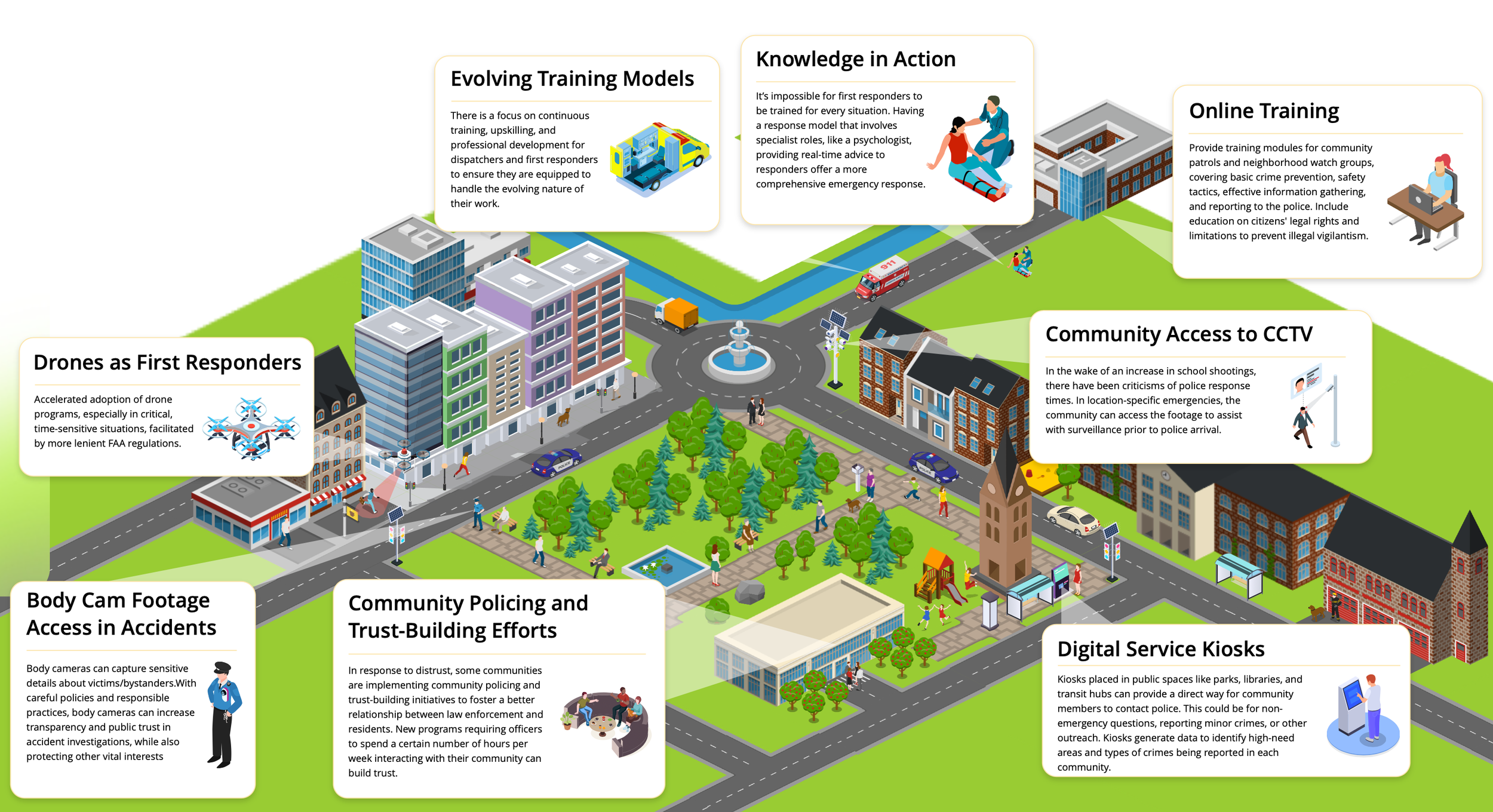
ReThinking 911
From Efficiency to Effectiveness
“911” typically refers to the emergency telephone number in North America, including the United States and Canada. It is a three- digit number that people can dial to connect with emergency services, such as police, fire, and medical assistance. The system is designed to provide a quick and easy way for individuals to request help in urgent situations. When someone dials 911, the call is routed to a local emergency dispatch center, where trained operators can assess the situation and dispatch appropriate emergency responders to the location. It’s an essential service for public safety and plays a crucial role in responding to various emergencies.
Everyday, an average of 600,000 people call 911 on their phones. Their concerns can range from anywhere between individually life-threatening & property damaging to coordinated evacuations.
-
Sai Allena
Rutuja Chavan
Jerick Evans
Nigencia James
Anish Patil
Dennis Siegert -
Shannon Delaney
Partners
City of Durham’s Community Safety Department
The Durham Community Safety Department works in close coordination with its 911 Emergency Call Center to connect Durham residents experiencing various quality-of-life concerns with the right care by sending new responses that better match residents’ needs. These new first response teams operate alongside their public safety partners in Police, Fire, and Emergency Medical Services (EMS) under the name of "HEART" (Holistic Empathetic Assistance Response Teams).
HEART's 4 crisis response units are:
Crisis Call Diversion (CCD): CCD embeds mental health clinicians in Durham's 9-1-1 call center.
Community Response Teams (CRT): CRT dispatches unarmed 3-person teams as first responders to non-violent behavioral health and quality of life calls for service.
Care Navigation (CN): Care Navigators follow up with people after meeting with one of our first responders to help connect to the community-based care they need and want.
Co-Response (CoR): CoR pairs clinicians with Durham police officers to respond to certain 911 calls for service that pose a greater potential safety risk.
Imagine a Building Collapse in a Downtown Area
In the heart of a bustling downtown area, a 911 call comes in reporting a catastrophic building collapse at a popular plaza. The caller describes a multi-story building that has crumbled, creating a chaotic and potentially life-threatening situation. Dust and debris fill the air, and there are fears of multiple people trapped inside the rubble.
911 Today; A system that prioritizes efficiency
The city's infrastructure is thoughtfully integrated with existing technologies to enhance public safety that work seamlessly together that allow expeditious police and ambulance dispatch.
A system that communicates to carry out key actions and prioritizes safety and efficiency
Flow of Influence
The 911 value flow
Competent Actions Foster Trust
Trust provides information and resources
Resources and information enable competent action
Drivers
Shifts in Trust
Distrust in Law Enforcement
A recent Gallup poll reveals that confidence in the police among American adults has dropped to 45%, a 3% decrease from the previous low of 48% recorded in 2020 after George Floyd’s death.
Diversity of emergency needs
Emphasis on training with considerations for privacy, ethical de-escalation, and community engagement, along with the adoption of augmented reality in training protocols for handling novel situations.
Shifts in Information
Increase in Call Volume, Leading to Overload
Influx of non-emergency phone calls is putting a strain on the current 911 system, leaving actual emergencies unanswered by outdated infrastructures already struggling to keep up
Multimodality of information
Implementation of NG911 systems is allowing dispatchers to receive text messages, images, videos, and other multimedia, providing more context to emergency situations.
Shifts in Resources
Police Recruitment Difficulties
The 2021 survey by the International Association of Chiefs of Police revealed widespread recruitment challenges for police, with 78% of agencies struggling to find qualified candidates and 65% experiencing a lack of applicants.
Focus on Precision Policing Models
Increasing adoption for focused, real-time, and technology-driven law enforcement strategies for better clearance rates and community relations.
Problem Space
Standardized actions are efficient in theory
But are increasingly ineffective in a changing landscape
Opportunity Space
In a changing landscape... Actions need to be adaptive!
Competency of action depends on transparency of information, trust and using the right tools & resources.
A fundamental and urgent shift is needed
From
Efficiency
Responsive
Siloed expertise
Standardized Data
Action-driven
Address standard needs
To
Effectiveness
Planned, responsive & reflective
Networked expertise
Inclusive Data
Trust & action-driven
Address diverse needs
An Efficient Future
Using resources and information to act quickly
In the ever-evolving landscape of adaptive actions, it becomes imperative for the underlying infrastructure to seamlessly accommodate the dynamic nature of requests and concerns.
By foreseeing potential issues and needs in advance, this technology acts as a proactive guardian, capable of averting accidents or emergencies before they unfold. This not only enhances the efficiency of the system but also contributes significantly to the overall safety and stability of the environment.
An Effective Future
Using mindful and competent actions to foster trust
The future of 911 envisions a collaborative harmony between communities and cutting-edge technology to foster a heightened sense of safety, trust, and transparency in actions and information dissemination
This shared responsibility enhances the overall efficiency of emergency services but also cultivates a culture of communal security. Moreover, the integration of emerging technologies ensures the self-sustainability of these systems.












